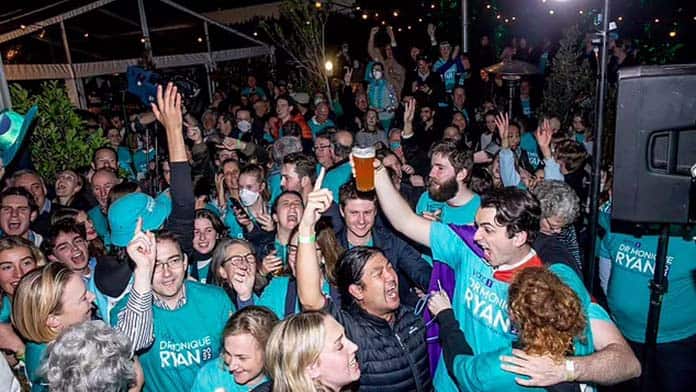The election has revealed the underlying crisis facing both the Coalition and Labor, with more than 31 per cent of voters opting for Greens, teal independents or other minor parties.
Despite winning, Labor’s primary vote went backwards on 2019 to its worst result since 1934, reflecting how much the election result vote was against the Liberals, rather than for Labor.
Labor bled votes to the teals and the Greens, putting climate action more centrally on the political agenda, but it also suffered major swings in core Melbourne and Sydney working class seats.
In the Sydney seat of Fowler, its vote crashed by more than 18 per cent as Labor’s shadow immigration minister Kristina Keneally was badly defeated, after being parachuted into a diverse, working class seat from her elite home in Scotland Island. In neighbouring Werriwa, the Labor vote was down 8 per cent.
Tellingly, in Melbourne, Labor’s vote plunged across the outer northern suburbs with the main benefit going to One Nation, the UAP and smaller rightwing parties.
In Calwell, Gorton and Scullin, Labor was down 9, 10 and 14 per cent respectively, with the right picking up 15, 18 and 18 per cent.
These were suburbs hit hard by COVID, with big numbers of workers who had no choice but to go to work in the teeth of the pandemic. They were also among the suburbs hit hardest by state Labor lockdowns, aggressive policing, fines and curfews.
With the bulk of the left endorsing those authoritarian measures, many workers felt abandoned. In Melbourne, it’s likely that many of those who voted One Nation or UAP were on the big anti-lockdown rallies.
It’s a warning that the left needs to provide a clear alternative not only to wage cuts and climate inaction, but to heavy-handed policing and state repression, whether by Liberal or Labor.
The ACTU’s electoral shift, swapping union rallies for corflutes, contributed to the fragmentation of the vote and added to the decline in workers identifying Labor as the party expressing their class interests.
Liberals’ crisis
For the Liberals, the open party of big business, with its primary vote the lowest since 1943, the problems are at another level. It has lost at least 17 seats including two ministers—ten seats to Labor, one to the Greens, and six to independents.
In Melbourne, where Treasurer Josh Frydenberg was humiliated, the Liberals hold just three metropolitan seats, all by wafer-thin margins.
Some MPs are arguing that the party should tilt further right. Liberal senator Alex Antic declared that the “Liberal Party’s experiment with the poison of leftism and progressivism must be over”.
Others on the so-called moderate wing of the party hope to pull the other way, one saying, “Morrisonism has got to be put to death.” There’s no likelihood of that under the new leadership of the racist warmonger, Peter Dutton.
But the more the Liberals go to the right, the less likely it is that they will beat the teal independents three years from now. A business party that can’t get elected presents a particular problem for the ruling class.
The tensions between the business establishment and the Liberal Party were obvious before the election as business pressured the Coalition to drop its climate denialism and adopt the internationally accepted target of net zero by 2050 in the lead up the COP26 international climate summit.
Businesswomen were disgusted with the Coalition’s unconcealed sexism. As former Transfield boss Diane Smith-Gander put it, “The Liberal Party ignored women completely and did not understand how obvious this was to the electorate.”
The teals revealed the rupture inside the Liberals’ base. As one Liberal put it, “I know a lot of the teal activists and financiers. These are liberals who haven’t left the Liberal Party—the Liberal Party has left them.”
Seeing the teals topple Liberal MPs was an election night pleasure, but the teals’ agenda of climate, integrity and gender equality is limited.
Zoe Daniels, who won the Melbourne seat of Goldstein, is typical. She calls herself an “economic conservative” and told The Age that she did not support cuts to private school funding. “I represent the people of Goldstein after all—there’s lots of private schools here.”
The Greens’ national vote increased around 2 per cent, but theirs is built around delivering change through parliamentary deals.
At the time of writing, Labor seemed almost certain of a majority in its own right. Any hopes The Greens and independents held of pushing Labor to the left by holding the lower house balance of power have vanished. Even with more Greens in the Senate, Labor will still be able to get support from the Liberals to get legislation passed.
The election has revealed a serious political crisis for Australia’s ruling class and a disconnect between the hopes for change and any prospect that parliamentary representation can fulfil those hopes.
The key to building on the election that brought an end to Morrison is struggle outside parliament. Building movements, strikes and demonstrations in the period ahead can win the real change that’s needed.
By David Glanz






